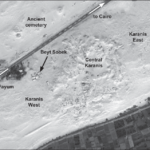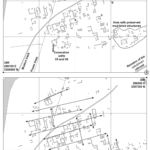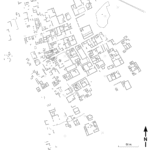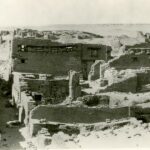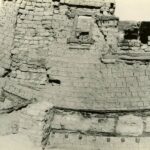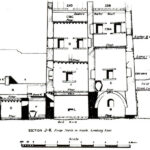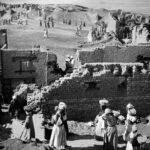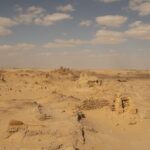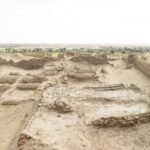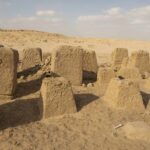KŪM AWŠĪM (KARANIS)
| Greek | Καρανίς |
| Arabic | كوم اوشيم |
| English | Karanis |
| French | Karanis |
| DEChriM ID | 41 |
| Trismegistos GeoID | 1008 |
| Pleiades ID | 736932 | PAThs ID | 106 |
| Ancient name | Karanis |
| Modern name | Kūm Awšīm |
| Latitude | 29.517899 |
| Longitude | 30.903071 |
| Date from | -304 |
| Date to | 650 |
| Typology | Village |
| Dating criteria | - |
| Description | Located on a kom that rises about twelve meters above the surrounding plain – the plain itself lying along a limestone ridge, which forms the northeastern rim of the Qarūn lake – Karanis is probably one of the better known villages of the Fayyūm, despite the fact, in the late nineteenth and early twentieth century, local farmers obtained government permits to remove great quantities of soil from the mound to use as fertilizer (sebbakh). Karanis, like Bakchias, provided an excellent source of sebbakh, the organic decay making the soil very rich. Nevertheless, the village returned an enormous amount of daily life objects – pots, lamps, glassware, textiles, jewels, metal works, furniture, tablewares, tools, toys, hair combs, harnesses, clothing, etc. – and above all papyri. - Paola Buzi |
| Archaeological research | Karanis was firstly explored in 1895 by the papyrologists P.B Grenfell and A.S. Hunt, who were followed in 1924/1925 by F.W. Kelsey, a professor of Latin language and literature at the University of Michigan, who was mainly interested in the objects related to daily life. For eleven seasons (1924-1935), Karanis became then the object of a systematic and accurate archaeological exploration and of a series of still very useful publications was produced. More recently, specific parts of the town were explored by the Cairo University in collaboration with the IFAO (1967-1975) – when, among the other discoveries, a very well preserved Roman bath was found (el-Nassery, Wagner, Castel 1976, 231-275) –, and lastly by a joint mission of the UCLA and the University of Groningen (Wendrich, Bos, Pansire 2006, 1-6). During the excavations of the University of Michigan among the numerous papyri found were documents that shed light on a wide variety of the financial, legal, political and social transactions and relationships of the Egyptian, Greek and Roman residents. Surprisingly, however, both archaeological and papyrological finds datable to Late Antiquity were not so numerous. As for the first aspect, the archaeologists of the University of Michigan did not identify any church or monastery and, on the basis of a lack of pottery remains and coins dated later than the fifth century, they were convinced that the site was abandoned between the end of the fourth century and the beginning of the fifth, an opinion that was re-proposed also in recent times (Bagnall 1993, 111, in part revised: Bagnall 2001, 234). It has been demonstrated, however, that many materials datable to the sixth-seventh centuries had been brought to the Kelsey Museum of Archaeology, were they are still awaiting for an appropriate study and publication (Pollard 1998, 147-162; Buzi 2006, 111-133). Moreover, a Late Antique Christian necropolis has been identified on the kom located on the other side of the road connecting Cairo with Madīnat al-Fayyūm (Buzi 2004, 97-106; Buzi 2006, 111-133). This occupies a series of little mounds on which the tombs are arranged in more or less regular rows and on more levels, being the bodies poorly embalmed and simply covered by a layer of sand. The presence of these Christian mummies – their faith being proved by a poor funerary kit that includes pendants with crosses – is evidenced by little mud brick truncated pyramids, that have the function of mark the location of the tombs. Already in the ’30s of the twentieth century, however, the specialists of the University of Michigan had described the re-use of some houses of the most external area of Karanis for Christian funerary purposes. From the textual point of view, it will be sufficient to mention the famous papyrus attesting to the first use of the term “monachos” to define a monk, a fact that clearly shows the presence of monks in Karanis (Judge 1977, 72-89). In brief, there is no doubt that Karanis had a Late Antique and Christian phase of occupation that lasted at least to the beginning of the seventh century. New archaeological explorations on the site and a re-evaluation of the papyrological materials – published and unpublished – will tell us more about it in the future. - Paola Buzi |
• Bagnall, R. S. 1993. Egypt in Late Antiquity, 111. Princeton: Princeton University Press.
• Bagnall, R. S. 2001. “Archaeological Work on Hellenistic and Roman Egypt.” American Journal of Archaeology 105: 234.
• Batcheller, J. C. 2013. “Late Roman Textiles from Karanis, Egypt: An Investigation into the Characterization of Archaeological Textiles.” PhD. Thesis. University of Manchester.
• Boak, A. E. R. 1926. “The University of Michigan’s Excavations at kKaranis: 1924-5.” Journal of Egyptian Archaeology 12: 19-21.
• Boak, A. E. R. ed. 1933. Karanis. The Temples Coin Hoards Botanical and Zoölogical reports. Seasons 1924-31. Ann Arbor: University of Michigan Press.
• Boak, A. E. R. 1955. “The Population of Roman and Byzantine Karanis.” Historia 4: 157-162.
• Boak, A. E. R. and E. E. Peterson. 1931. Karanis. Topographical and Architectural Report of the Excavations During the Seasons 1924-28. Ann Arbor: University of Michigan Press.
• Buzi, P. 2004. “Lo scavo di una necropolis di età tardo-antica a Karanis (Kom Aushim): alcune annotazioni.” Ricerche di egittologia e di antichità copte 6: 97-106.
• Buzi, P. 2006. “Ancora sulla necropoli tardo-antica di Karanis: indizi per lar determinazione della datazione del definitivo abbandono del sito.” In Il Coccodrillo e il Cobra. Aspetti dell'universo religioso egiziano nel Fayyum e altrove, Bologna 20-21 aprile 2005, edited by S. Pernigotti and M. Zecchi, 111-133. Imola: La Mandragora.
• Davoli, P. 1998. L’archeologia urbana nel Fayyum di età Ellenistica e Romana, 73-90. Napoli: G. Procaccini.
• El-Nassery, S. A. A. and G. Wagner. 1975. “A New Roman Hoard from Karanis (IIIrd Century A.D.).” Bulletin de l'Institut français d'archéologie orientale 75: 183-202.
• El-Nassery, S. A. A., G. Wagner and G. Castel. 1976. “Un grand bain gréco-romain à Karanis. Fouilles de l’Université du Caire (1972-75).” Bulletin de l'Institut français d'archéologie orientale 76: 231-275.
• Gazda, E. K. 1983. Karanis: An Egyptian Town in Roman Times. Ann Arbor: University of Michigan Press.
• Gazda, E. K. et al. 1978. Guardians of the Nile: Sculptures from Karanis in the Fayoum (c. 250 B.C.-A.D. 450). Ann Arbor: University of Michigan Press.
• Geremek, H. 1969. Karanis: communauté rurale de l’Égypte romaine au II-III siècle de notre ère. Wroklaw, Warsaw, Kraków: Zakład Narodowy im. Ossolińskich-Wydawnictwo Polskiej Akademii Nauk.
• Haatvedt, R. A. and E. E. Peterson. 1964. Coins from Karanis. Ann Arbor: University of Michigan Press.
• Harden, D. B. 1936. Roman Glass from Karanis Found by the University of Michigan Archaeological Expedition in Egypt, 1924-29. Ann Arbor: University of Michigan Press.
• Husselman, M. 1975. Karanis: Excavations of the University of Michigan in Egypt, 1928-1935. Topography and Architecture. Ann Arbor: University of Michigan Press.
• Judge, E. A. 1977. “The Earliest Use of Monachos for Monk and the Origin of Monasticism.” Journal of Ancient Civilisations 20: 72-89.
• Pollard, N. 1998. “The Chronology and Economic Condition of Late Roman Karanis: An Archaeological Reassessment.” Journal of the American Research Center in Cairo 35: 147-162.
• Timm, S. ed. 1984-1992. Das Christliche-Koptische Ägypten in Arabischer Zeit: Eine Sammlung Christicher Stätten in Ägypten in Arabischer Zeit unter Ausschyss von Alexandria, Kairo, des Apa-Mena-Klosters (Dēr Abū Mina), der Skētis (Wādi n-Naṭrūn) und der Sinai-Region, Vol. 3, 1222-1224. Weisbaden: Dr Ludwig Reichert.
• Van Minnen, P. 1994. “House-to-House Enquiries: An Interdisciplinary Approach to Roman Karanis.” Zeitschrift für Papyrologie und Epigraphik 100: 227-251.


 Json data
Json data